Uveal Melanoma and the Lynch Syndrome Tumor Spectrum
IF 7.8
1区 医学
Q1 OPHTHALMOLOGY
引用次数: 0
Abstract
ImportanceTo date, no environmental factors and few therapeutic options are known for uveal melanoma (UM), the most common malignant intraocular primary tumor in adults. Identification of new predisposition factors could lead to better monitoring and possibly improved treatments of patients with UM.ObjectiveTo identify new genetic alterations predisposing for UM.Design, Setting, and ParticipantsThis was a prospective cohort study conducted at Institut Curie in Paris, France, among 381 consecutive patients diagnosed with UM between July 2021 and February 2023. UM was diagnosed clinically by ophthalmologists, and a senior pathologist confirmed the diagnosis when tumor or biopsy was available. All participants received genetic counseling and consented to extended genetic testing. A panel of 122 genes predisposing to cancer were analyzed by targeted sequencing on germline DNA from these patients.Main Outcomes and MeasuresFrequency of pathogenic variants (PVs) in genes from a targeted panel, with classification of germline PVs done according to the American College of Medical Genetics and Genomics guidelines and the French Unicancer Genetics Group.ResultsA total of 79 PVs were identified in 70 participants (41 female and 29 male; mean [SD] age, 60.6 [15.3] years). Among them, 21 were found in clinically relevant genes, with an enrichment in the mismatch repair (MMR) genes, involved in Lynch syndrome, a frequent predisposition to colon and endometrial cancers. This finding suggested MMR germline PVs could also predispose to UM. One tumor was available from a participant carrying a葡萄膜黑色素瘤和Lynch综合征肿瘤谱
迄今为止,对于成人最常见的眼内原发性恶性肿瘤——葡萄膜黑色素瘤(uveal melanoma, UM),没有环境因素和很少的治疗选择。识别新的易感因素可以更好地监测并可能改善UM患者的治疗。目的寻找易致UM的新遗传变异。设计、环境和参与者:这是一项在法国巴黎居里研究所进行的前瞻性队列研究,研究对象为2021年7月至2023年2月期间连续诊断为UM的381例患者。UM由眼科医生临床诊断,当有肿瘤或活检时由资深病理学家确诊。所有参与者都接受了遗传咨询,并同意进行进一步的基因检测。通过对这些患者的种系DNA进行靶向测序,分析了122个易患癌症的基因。主要结果和测量指标靶组基因致病性变异(pv)的频率,根据美国医学遗传学和基因组学学院指南和法国Unicancer遗传学小组对生殖系pv进行分类。结果70名参与者共发现79个pv(女性41个,男性29个;平均[SD]年龄,60.6[15.3]岁)。其中21个与临床相关基因相关,其中错配修复(MMR)基因富集,参与Lynch综合征,结肠癌和子宫内膜癌的常见易感性。这一发现表明MMR生殖系pv也可能易患UM。一例肿瘤来自携带MLH1种系PV的参与者。肿瘤表现为单体3,缺失位于3号染色体上的MLH1野生型等位基因。免疫组化观察到MLH1的表达缺失,从该肿瘤的全基因组测序中鉴定出MMR变异特征SBS6、ID1和ID2,支持MLH1参与该肿瘤发生的可能性。结论和相关性这项对UM患者的前瞻性生殖系研究提供了证据,支持MMR生殖系改变在UM患者中丰富的观点,并可能促进UM的肿瘤发生,因此UM可能是Lynch综合征的一种罕见肿瘤表现。
本文章由计算机程序翻译,如有差异,请以英文原文为准。
求助全文
约1分钟内获得全文
求助全文
来源期刊

JAMA ophthalmology
OPHTHALMOLOGY-
CiteScore
13.20
自引率
3.70%
发文量
340
期刊介绍:
JAMA Ophthalmology, with a rich history of continuous publication since 1869, stands as a distinguished international, peer-reviewed journal dedicated to ophthalmology and visual science. In 2019, the journal proudly commemorated 150 years of uninterrupted service to the field. As a member of the esteemed JAMA Network, a consortium renowned for its peer-reviewed general medical and specialty publications, JAMA Ophthalmology upholds the highest standards of excellence in disseminating cutting-edge research and insights. Join us in celebrating our legacy and advancing the frontiers of ophthalmology and visual science.
 求助内容:
求助内容: 应助结果提醒方式:
应助结果提醒方式:


